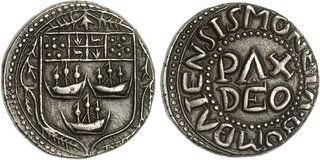Lot description:
INDIA, Colonial. British India. Bombay Presidency. 1662-1835. AR Anglina (24mm, 11.79 g, 9h). Bombay mint. Undated, but struck 1676 to 1692. Company coat-of arms; shield surrounded by floral design / MONETΛ · BOMBΛIENSIS, PΛX/DEO in two lines; · below Λ. CEEIC 1.8; Pridmore 17; KM 140. In NGC encapsulation 6381640-002, graded AU 53. Conservatively graded by NGC in our opinion. Reverse slightly off center. Richly toned. A handsome and well struck example of this very rare and and desirable type.
Ex Robert P. Puddester Collection; F. Pridmore Collection (Part II, Glendining, 18 October 1982), lot 449, purchased from Spink, February 1983; H. A. Parsons Collection (Part II, Glendining, 11 May 1954), lot 886.
When Charles II married Catherine of Braganza in 1662, part of her large dowry was the island of Bombay, which had previously been a Portuguese possession. It was not until 1665, however, that Bombay became a possession of the East India Company. It is recorded that the first inquiries were made about obtaining minting equipment from London late in 1668, but it was only in 1672 that the Company wrote back to the President and Council in Surat, agreeing that '...Wee doe thinck it convenient for us to have a coyne of our owne there. Wee would have you therefore consider of such a coyne, soe as it bee not our Kings Majesties or any stampe resembling the same, and of such sorts as will best suite with the traffique and exchange of the country, both in bigger and lesser speties. And if you shall find it necessary to have for change a small sort of copper coyne, let it apeare to be what it is , but what you shall coyne of gold or silver, let it have an intrinsique value as to what it is stampt for, that it may be to our honnor and the begetting and preserving the esteeme thereof.'. A subsequent letter, dated December 21 1672, sheds interesting light on the Company's motives for striking its own coinage, noting that 'We had often serious debate, and tooke the best advise we could of the banians, sherofifs, and others that could direct us; and have concluded that the gold and silver coyne shall be exactly in weight and finenesse equall with the rupee of Surratt. The reason is because they will vend the more currantly in the neighbouring countrys of the Portuguese, Sevagee and Decan, and in time probably passe as currantly in payments, which will be a notable accommodation to the trade of the island, if we can bring it soe about.
The specimen offered here is an extremely rare example of the third type of silver anglina issued, introduced in 1676. Unlike the two previous types, it omits the Company's title from the marginal legend around the coat of arms, and replaces the longer A DEO PAX ET INCREMENTUM ('From God come Peace and Profit') used on the earlier silver coins with the much shorter PAX DEO ('Peace from God'). In accordance with the letters quoted above, its weight was intended to be equivalent to that of contemporary Surat rupees (although it seems that these were felt to be of slightly better fineness and weight than early anglinas), and these new coins were intended to play their part in the Company's continued expansion and growth into India.
Estimate: 15000 USD |  |